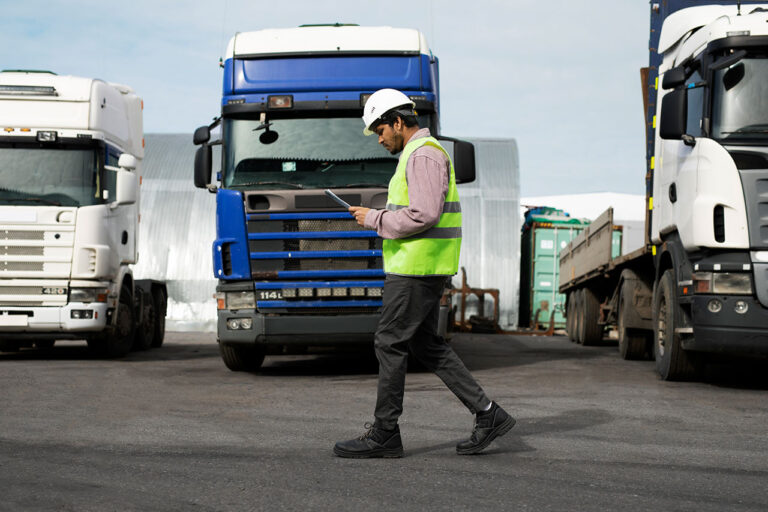Technology has revolutionized how businesses operate, and the trucking industry is no exception. An Uber-like app for trucks can streamline the entire logistics process, from connecting shippers with carriers to tracking shipments in real time. If you plan to build an Uber-like app for trucks, this comprehensive guide is for you.
This article will discuss everything you need to know about building an app that can revolutionize the trucking industry.
Table of Contents
Understanding the Market and Business Model
Before building an Uber-like app for trucks, you need to understand the market and identify your target audience. The trucking industry is a vast market, and your app’s success depends on how well you understand your users’ needs.
Here are some key factors to consider when analyzing the market:
Identifying the Target Audience and Competition
Your target audience for the Uber-like app for trucks could be shippers, carriers, or both. You need to understand their needs and pain points to build an app that can cater to their requirements. For shippers, their main concerns could be finding reliable carriers, tracking shipments, and getting real-time updates on shipment status. For carriers, their main concerns could be finding new business opportunities, managing their fleet, and optimizing routes.
You should also analyze the competition and see what features they offer, how they market their app, and what their pricing strategy is. This will help you identify gaps in the market and come up with unique features that can differentiate your app from the competition.
Analyzing the Existing Market Landscape
Before building an Uber-like app for trucks, you need to analyze the existing market landscape. You can look at the market size, growth potential, and trends in the trucking industry. According to a report by Research and Markets, the global logistics market is expected to grow at a CAGR of 7.5% from 2021 to 2028. This presents a significant opportunity for new players in the market.
Another trend in the trucking industry is the adoption of digital technologies. According to a report by McKinsey, the trucking industry could benefit from digitization in several ways, including route optimization, predictive maintenance, and real-time tracking. By understanding the market, you can build an app that is both scalable and sustainable.
Business Model
Once you have identified your target audience and analyzed the market, you need to come up with a business model for your Uber-like app for trucks. There are several business models you can choose from, such as:
Commission-based Model
In this model, you charge a commission on each transaction that takes place on your platform. For example, if a shipper pays a carrier $100 for a shipment, you can charge a commission of 10%, which would be $10.
Subscription-based Model
In this model, you charge a monthly or annual subscription fee to access your platform. This model works well if you offer premium features that are not available in the free version.
Freemium Model
In this model, you offer a basic version of your app for free and charge for premium features. This model works well if you have a large user base and can convert a small percentage of users into paying customers.
Key Features of an Uber-like App for Trucks
When building an Uber-like app for trucks, it’s important to include key features that cater to the needs of both shippers and carriers.
Here are some essential features to consider:
- Real-time Tracking: Real-time tracking is an essential feature that allows shippers and carriers to track the shipment’s status in real-time. This feature helps shippers to monitor their shipment’s progress and carriers provide real-time updates to shippers.
- In-app Messaging: In-app messaging is a feature that allows shippers and carriers to communicate with each other in real time. This feature helps shippers to get updates on their shipments and carriers ask questions or provide updates.
- Document Management: Document management is a feature that allows shippers and carriers to upload and manage shipment-related documents. This feature helps shippers to upload invoices, bills of lading, and other documents, and carriers to upload proof of delivery and other documents.
- Route Optimization: Route optimization is a feature that allows carriers to optimize their routes based on the shipment’s destination and other factors such as traffic, road conditions, and fuel costs. This feature helps carriers to reduce their transportation costs and improve their efficiency.
- Payment Gateway Integration: Payment gateway integration is a feature that allows shippers to make payments for their shipments directly through the app. This feature helps to simplify the payment process and reduce the need for manual invoicing and payment collection.
- Rating and Review System: A rating and review system is a feature that allows shippers and carriers to rate and review each other based on their experience. This feature helps to build trust and transparency in the platform and also helps other users to make informed decisions when choosing a carrier or shipper.
Tech Stack for Uber-like app for Trucks
The tech stack you choose will depend on your app’s requirements, budget, and scalability. Here are some popular technologies used for developing Uber-like apps:
- Backend: Node.js, Ruby on Rails, Python, or Java.
- Frontend: React Native, AngularJS, or Vue.js.
- Database: MySQL, MongoDB, or PostgreSQL.
- Cloud Infrastructure: AWS, Microsoft Azure, or Google Cloud.
- Payment Gateway: Stripe, Braintree, or PayPal.
Development Process
The development process for an Uber-like app for trucks typically involves the following steps:
Requirement Gathering: Understanding the business requirements, identifying the target audience, and defining the app’s features and functionalities.
UI/UX Design: Creating wireframes, and user flow diagrams, and designing the app’s UI/UX.
Backend Development: Setting up the server-side infrastructure, creating APIs, and integrating with third-party services.
Frontend Development: Building the user interface and integrating it with the backend.
Testing: Conduct manual and automated testing to ensure the app is functioning correctly and is bug-free.
Deployment: Deploying the app to production servers, setting up continuous integration and delivery, and configuring the app for scaling.
Maintenance and Support: Monitoring the app’s performance, fixing bugs, and providing ongoing support to users.
Cost to Build Uber-like App for Trucks
The cost of building an Uber-like app for trucks can vary significantly depending on several factors, including the app’s features, complexity, and the development team’s location.
Here’s the estimated cost of building an Uber-like app for trucks:
| Development Stage | Time Required | Web Development Cost | Android Development Cost | iOS Development Cost |
|---|---|---|---|---|
| UI/UX Design | 80-100 hours | $3,000 – $5,000 | $2,500 – $5,000 | $3,000 – $5,000 |
| Backend Development | 300-400 hours | $10,000 – $20,000 | $15,000 – $25,000 | $15,000 – $25,000 |
| Frontend Development | 250-350 hours | $8,000 – $15,000 | $12,000 – $20,000 | $12,000 – $20,000 |
| Testing & Deployment | 100-150 hours | $3,000 – $5,000 | $5,000 – $7,500 | $5,000 – $7,500 |
| Total | 730-1,000 hours | $24,000 – $45,000 | $35,500 – $58,500 | $35,000 – $58,500 |
Marketing and Promotion Strategies
Developing an Uber-like app for trucks is only one part of the equation. To make it successful, you also need to have a solid marketing and promotion strategy.
Here are some marketing and promotion strategies that you can use to promote your app and attract truckers:
Use Social Media
Social media platforms like Facebook, Instagram, Twitter, and LinkedIn can help you reach a broader audience. You can create engaging content and share it on social media to increase brand awareness and attract potential users.
App Store Optimization (ASO)
Optimizing your app’s description and keywords on the app store can help your app rank higher in search results. This can help increase your app’s visibility and attract more users.
Referral Programs
Offering referral programs to your existing users can be an effective way to incentivize them to invite their friends and family to use your app. This can help you acquire new users and increase app downloads.
Influencer Marketing
Collaborating with influencers or bloggers in the trucking industry can help you reach a targeted audience. You can sponsor their content or ask them to review your app, which can help increase your app’s visibility and attract new users.
Paid Advertising
Running paid advertising campaigns on social media or search engines can help you reach a broader audience. You can target your ads based on demographics, location, and interests, which can help you attract potential users who are more likely to use your app.
PR and Press Coverage
Getting press coverage can help increase brand awareness and attract potential users. You can reach out to industry publications, blogs, or journalists who cover the trucking industry and pitch your story.
Wrapping up
Building an Uber-like app for trucks requires careful planning, execution, and marketing. By understanding the market, identifying your target audience, and choosing the right business model, you can build an app that can revolutionize the trucking industry.
The key to success is to offer unique features, provide excellent customer service, and stay up to date with the latest trends and technologies.
FAQs
Q: How much does it cost to build an Uber-like app for trucks?
Ans: The cost of building an Uber-like app for trucks depends on several factors, including the complexity of the app, the features you want to include, and the development team’s hourly rates. On average, the cost of building an Uber-like app for trucks can range from $50,000 to $150,000 or more.
Q: How long does it take to develop an Uber-like app for trucks?
Ans: The development timeline for an Uber-like app for trucks can vary depending on the scope and complexity of the project. On average, it can take anywhere from 6 to 12 months or more to develop an app like this. Factors that can impact the development timeline include the number of features, the development team’s size, and the technology stack.
Q: How do I ensure the security of my app and data?
Ans: To ensure the security of your app and data, you should implement robust security measures, such as using encryption, firewalls, and secure authentication methods. You should also conduct regular security audits and penetration testing to identify and address potential vulnerabilities.
Q: Do I need to have the technical expertise to build an Uber-like app for trucks?
Ans: While having technical expertise can be beneficial, it is not necessary to build an Uber-like app for trucks. You can hire a professional development team that has experience in building similar apps to handle the technical aspects of the project. However, having a basic understanding of the development process and technology stack can help you communicate better with the development team and ensure that the project meets your expectations.
Q: How do I ensure user engagement and retention in my app?
Ans: To ensure user engagement and retention in your app, you should focus on delivering a seamless user experience, providing valuable features and services, and continually improving your app based on user feedback. You can also incentivize user engagement by offering rewards or discounts for completing certain actions, such as referring friends or completing deliveries.






















+ There are no comments
Add yours